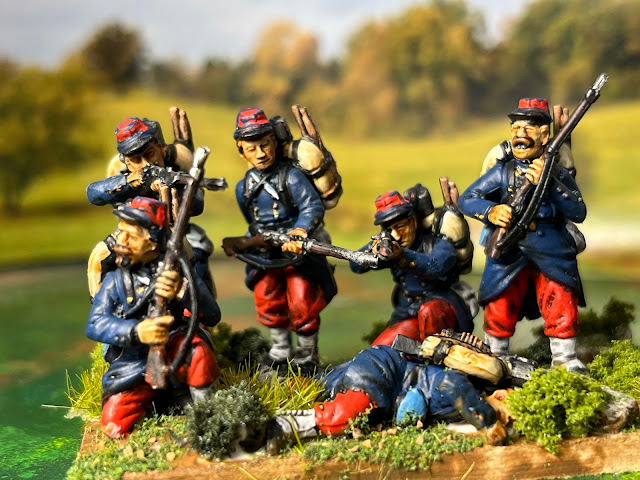Friday, 30 June 2023
Second Battalion, 76e Régiment d'Infanterie
Tuesday, 27 June 2023
3e Bataillon de Chasseurs à Pied
Chasseurs had been a part of the French army since the of the 18th Century or earlier, but the Chasseurs à Pied of 1870 had their origins in the late-1830s as an informal unit called the Tirailleurs d'Afrique that was given a formal establishment in September 1839, based in Vincennes and named the Chasseurs de Vincennes. Under the colonelcy of the Duc d'Orleans they were trained as true light infantry and proved themselves highly effective in the campaigns in North Africa, so effective that in August 1840 a further nine battalions were established as a separate corps by royal decree. On the death of the Duc in 1842 they were named the Chasseurs d'Orleans in his honour. After the revolution of 1848 the battalions became known as Chasseurs à Pied. By 1870 there were twenty battalions in service.
The 3e Chasseurs were formed in 1840 and spent the next eight years in North Africa. Returning to France in 1848 the battalion went to the Crimea in 1853 and was fort in the battles of the Alma and Inkerman and were involved in the storming of the Mamelon-Vert at Sevastopol. Not engaged in the Italian campaign, the battalion formed a part of the garrison of the Pontifical States from 1860-65.
In the structure of the army in 1870 one Chasseur battalion was assigned to each infantry division. The 3e was assigned to Verge's Division, 2nd Corps (which is why it is a part of my collection), under Commandant Thoma. Heavily engaged at Spicheren it lost 6 officers and 225 men from 452 engaged. It fought again at Rezonville and Gravelotte and surrendered at Metz in October.
The depot companies formed the basis of the 3e Chasseurs de Marche and served in 16th Corps in the Army d'Loire, fighting at Valliere, Loigny and Moree.
In the Great War the battalion fought from day one to the very end of the war across almost every point of the western front from Belgium to Belfort, and counted 2,039 officers and enlisted men killed during the war.
Disbanded in 1929, it was restored in 1939, only to be disbanded again after the Fall of France the following year. Reconstituted in 1949 it was disbanded for good in 1955.
These are lovely figures, full of character, but the rifles and bayonets on the figures are very thin and I am concerned how they will stand up to handling during games.
Monday, 26 June 2023
War in the Crimea
Yesterday I arranged a Crimean War game. Having spent all last week on holiday I had given very little thought to the scenario, in fact the whole game was conceived on the morning of the game.
The Russians were to be in position more or less diagonally across the table with 35 battalions, five large batteries and four cavalry regiments. The Allied were to attack with 13 British battalions (including three battalions of Guards) and five standard batteries, ten small cavalry regiments (the Heavy and Light Brigades), the French with 13 battalions and two standard batteries, and the Turks with four battalions and two standard batteries. While the Russians had greater numbers of infantry battalions, they were slower moving than the Allies and their dense formations made them more vulnerable to fire. The British infantry, the French Chasseurs and Zouaves were armed with rifled muskets and enjoyed a range advantage.
The Allies chose to hit the Russian left with the bulk of their force, hoping that the troops on the Russian right could be kept out of the fight for as long as possible. Keith, who commanded the British infantry, filed a much more detailed report than I can give here.
In the end, after a hard fought battle, the Russians were driven back, although the British and Turkish forces took a heavy bashing.
 |
| The Russians advance |
 |
| "Forward the Light Brigade"...sadly they suffered much the same fate as the original brigade |
 |
| French troops moving forward |
 |
| The Scots Greys going forward |
 |
| The Light Brigade about to be shot to pieces |
 |
 |
| A Russian battery about to be ridden down by the Royals |
 |
| The Zouaves press on |
 |
| The 11th Hussars are broken while charging a Russian square |
 |
| Here they come! |
 |
| The developing fight on the Russian left |
 |
| The infantry form for the fight |
 |
| The French have arrived at the front |
 |
| The confusion on the Russian left... |
 |
| The French are unstoppable... |
 |
| ...and have broken the Russian left. |
 |
| The Heavy Brigade advancing |
Saturday, 24 June 2023
First Battalion, 77e Régiment d'Infanterie
Identified by its red fanion this is Commandant Mezerin's First Battalion, 77e Régiment de Ligne, the final battalion of the regiment.
For anyone interested in the weaponry of the Franco-Prussian War, Steve Shann (who wrote two Osprey Men at Arms books on the French armies in 1870-71 and has published several other wargaming books) is about to publish a work on the mitrailleuse, the details of which can be found here https://steve-nationsinarms.blogspot.com/2023/06/new-book.html
Meanwhile here is the whole of the 77e Régiment deployed.
Wednesday, 21 June 2023
A Big Week
 |
| The Lakeshore on Sunday evening |
 |
| Pre-dinner drinks in the Lodge lounge - the view from my seat. |
































